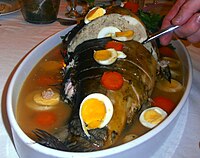Gefilte fish
The earliest historical reference to gefuelten hechden (stuffed pikes) comes from Daz Buoch von Guoter Spise (The Book of Good Food), a Middle High German cookbook dating to circa 1350 CE.
Gefuelten hechden consisted of poached and mashed pike that was flavored with herbs and seeds, stuffed back inside the fish skin, and then roasted.
By the Middle Ages, stuffed fish had migrated into the cuisine of German and Eastern European Jews.
[7] Gefilte fish is typically garnished with a slice of carrot on top, and a horseradish mixture called chrain on the side.
Different preparations and taste preferences may be a proxy for reflecting Ashkenazi Jews' specific ancestral origins in Europe.
The boundary separating the two camps was dubbed "the Gefilte Fish Line" by Yiddish linguist Marvin Herzog in the mid-1960s.
Culinary historian Gil Marks quipped that, '"Other Jews had savory noodle kugels.
'[12] The late 1930s brought a brand named Mother's from "Sidney Leibner, the son of a fish store owner.
The patent for this jelly, which allowed mass-market distribution of gefilte fish, was granted on October 29, 1963, to Monroe Nash and Erich G.
[16][17] In Polish Catholic homes (more commonly in the northern regions near the Baltic Sea), gefilte fish (Polish: karp po żydowsku) is a traditional dish to be eaten on Christmas Eve (for twelve-dish supper) and Holy Saturday, as these are traditionally meatless feasts.
[2] This follows a pattern in which a number of Jewish non-meat dishes were also eaten on Catholic religious days in Poland.

